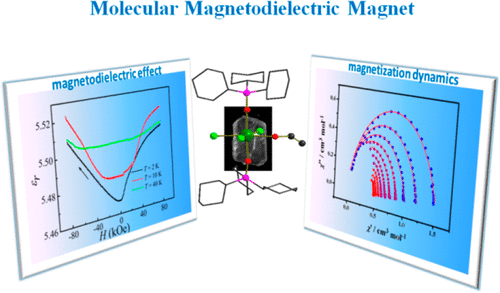当前位置:
X-MOL 学术
›
J. Am. Chem. Soc.
›
论文详情
Our official English website, www.x-mol.net, welcomes your
feedback! (Note: you will need to create a separate account there.)
Observation of Magnetodielectric Effect in a Dysprosium-Based Single-Molecule Magnet
Journal of the American Chemical Society ( IF 14.4 ) Pub Date : 2018-06-12 , DOI: 10.1021/jacs.8b04818 Yu-Xia Wang 1, 2 , Yinina Ma 3 , Yisheng Chai 3 , Wei Shi 1 , Young Sun 3 , Peng Cheng 1, 2
Journal of the American Chemical Society ( IF 14.4 ) Pub Date : 2018-06-12 , DOI: 10.1021/jacs.8b04818 Yu-Xia Wang 1, 2 , Yinina Ma 3 , Yisheng Chai 3 , Wei Shi 1 , Young Sun 3 , Peng Cheng 1, 2
Affiliation

|
Materials that possess coupled magnetic and electric properties are of significant interest because of their potential use in next-generation magnetoelectric devices such as digital information storage. To date, the magnetoelectric materials that have been studied in-depth have been limited mainly to inorganic oxides such as perovskite oxides. Molecular materials are a promising alternative because their magnetic and electric elements can be combined together at the molecular level via relatively simple molecular designs. Here, we report the coupling of magnetic and electric properties through a magnetodielectric (MD) effect in a single-crystal sample, which is constructed from dysprosium(III) single-molecule magnets (SMMs). The MD effect originates from intrinsic spin-lattice coupling of the dysprosium(III) ion within the sample. This is the first observation of the MD effect in a SMM-based material, which could pave the way toward the synthesis of advanced materials that combine distinct magnetic and electric properties using molecular chemistry for use in molecular devices with nanoscale size.
中文翻译:

镝基单分子磁铁中磁介电效应的观察
具有耦合磁电特性的材料因其在下一代磁电设备(如数字信息存储)中的潜在用途而备受关注。迄今为止,深入研究的磁电材料主要局限于钙钛矿氧化物等无机氧化物。分子材料是一种很有前景的替代品,因为它们的磁性和电气元素可以通过相对简单的分子设计在分子水平上结合在一起。在这里,我们通过单晶样品中的磁介电 (MD) 效应报告了磁和电特性的耦合,该样品由镝 (III) 单分子磁体 (SMM) 构成。MD 效应源于样品中镝 (III) 离子的固有自旋晶格耦合。
更新日期:2018-06-12
中文翻译:

镝基单分子磁铁中磁介电效应的观察
具有耦合磁电特性的材料因其在下一代磁电设备(如数字信息存储)中的潜在用途而备受关注。迄今为止,深入研究的磁电材料主要局限于钙钛矿氧化物等无机氧化物。分子材料是一种很有前景的替代品,因为它们的磁性和电气元素可以通过相对简单的分子设计在分子水平上结合在一起。在这里,我们通过单晶样品中的磁介电 (MD) 效应报告了磁和电特性的耦合,该样品由镝 (III) 单分子磁体 (SMM) 构成。MD 效应源于样品中镝 (III) 离子的固有自旋晶格耦合。











































 京公网安备 11010802027423号
京公网安备 11010802027423号